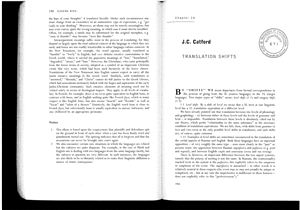A new approach to translation equivalence
BY SHIFTS we mean departures from formal correspondence in the process of going from the SL (source language) to the TL (target language). Two major types of shifts occur:
level shifts (1.1) and category shifts (1.2).
1.1 Level shifts. By a shift of level we mean that a SL item at one linguistic level has a TL translation equivalent at a different level. We have already pointed out that translation between the levels of phonology and graphology — or between either of these levels and the levels of grammar and lexis — is impossible. Translation between these levels is absolutely ruled out by our theory, which posits relationship to the same substance as the necessary condition of translation equivalence. We are left, then, with shifts from grammar to lexis and vice-versa as the only possible level shifts in translation; and such shifts are, of course, quite common.
BY SHIFTS we mean departures from formal correspondence in the process of going from the SL (source language) to the TL (target language). Two major types of shifts occur:
level shifts (1.1) and category shifts (1.2).
1.1 Level shifts. By a shift of level we mean that a SL item at one linguistic level has a TL translation equivalent at a different level. We have already pointed out that translation between the levels of phonology and graphology — or between either of these levels and the levels of grammar and lexis — is impossible. Translation between these levels is absolutely ruled out by our theory, which posits relationship to the same substance as the necessary condition of translation equivalence. We are left, then, with shifts from grammar to lexis and vice-versa as the only possible level shifts in translation; and such shifts are, of course, quite common.

